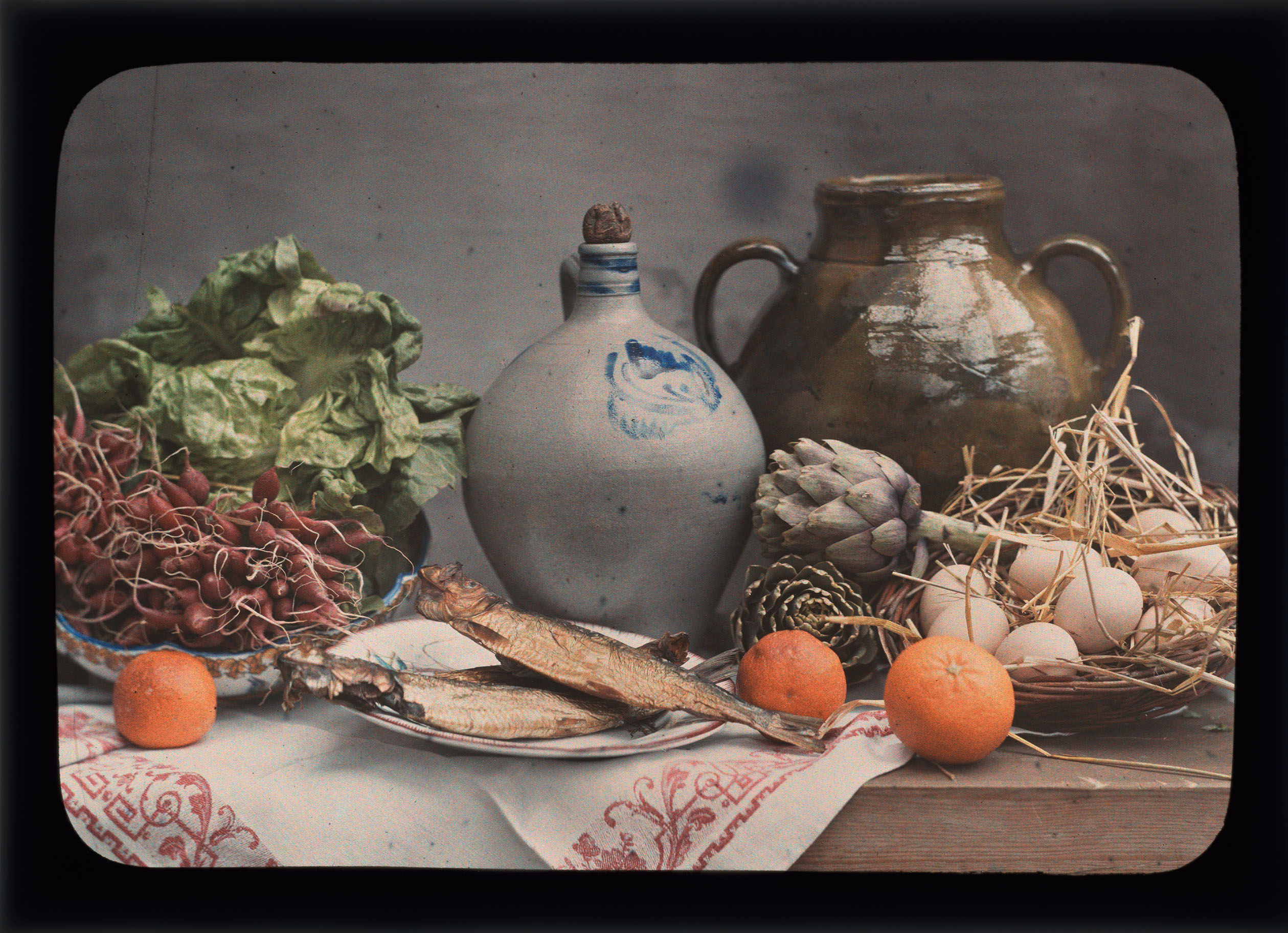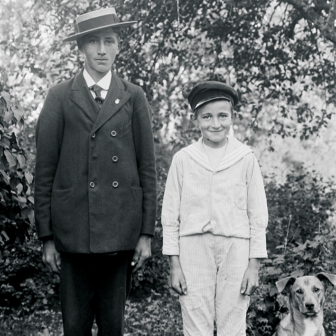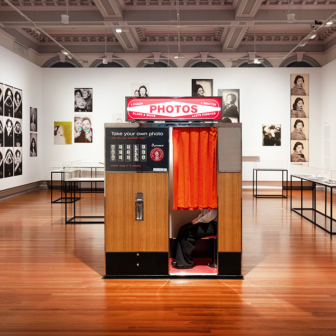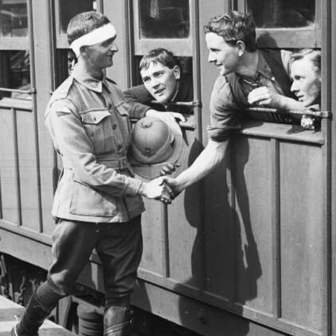So entirely are we used to thinking of photographic images as records of the past, a past that may have been anything from almost 200 years to an hour ago, that it is hard to come to grips with how this is changing. With the assistance of artificial intelligence, photography looks set to leave behind this fundamental relationship — between the present of the image in front of us and the past it captures or in some way evokes — and replace it with something rather different.
Traditional photography, as we seem destined to refer to daguerreotype or digital or anything in between, records something captured in what immediately becomes the past. That doesn’t mean a photograph represents a historical truth — there are many ways, including deliberate fakery, by which the camera can lie. But however much an image may trick or mislead us, we can still be confident that it has its roots in history, that something happened, even if that something was designed to fool us.
That is what is changing. AI images fundamentally challenge the relationship of the image with the past. It is true that AI image-making (or AI-assisted, as some would more carefully express it) does in one sense depend on the past, in the form of the vast number of extant photographic images that AI draws upon to do its work. But the resulting “photography-like” image is indeed new — the person, the object, the event that it depicts did not exist. Nothing, so to speak, happened.
Given the way the ground is shifting, it isn’t surprising that we are witnessing an upsurge of interest in telling photography’s story so far. The huge stocks of photographs held by galleries and libraries and museums, sometimes deliberately collected but often accumulated almost by chance, are increasingly being brought to the forefront, as curators and historians of photography grapple with the most effective ways of displaying and contextualising examples from the vast stocks of images at their disposal.
Three current exhibitions — one at the National Gallery of Victoria, the others at the State Library of New South Wales and the National Archives of Australia — reflect this upsurge of interest. In the words of David Campany, a contributor to the splendid catalogue of the NGV exhibition, Photography: Real and Imagined, photography “finds itself centre stage again.”
The NGV first began collecting photographs more than fifty years ago with a brief “to acquire both Australian and international photography.” The collection began with an emphasis on documentary photography but moved rapidly into what, to use the shorthand, is generally termed art photography. This distinction may once have seemed clearer than it does now, when we are much more likely, as Susan Bright writes in her catalogue essay, to see photographs as belonging “on the spectrum,” somewhere between the polarities of reality and imagination.
Whether a photograph is seen as real or imagined, as documentary or art, amateur or professional, these categories are in fact “intertwined,” to use Bright’s term; whatever its status, whether as snapshot or artistic triumph, the photograph is evidence of something that happened in the past.
Among the exhibits at the NGV is German photographer Thomas Struth’s well-known image Pergamon Museum IV, Berlin (2001). It shows a group of gallery visitors posed in the act of viewing the Telephos frieze in the Pergamon Museum in Berlin. For all kinds of reasons, including scale and complexity of composition, Struth’s image announces itself as art.
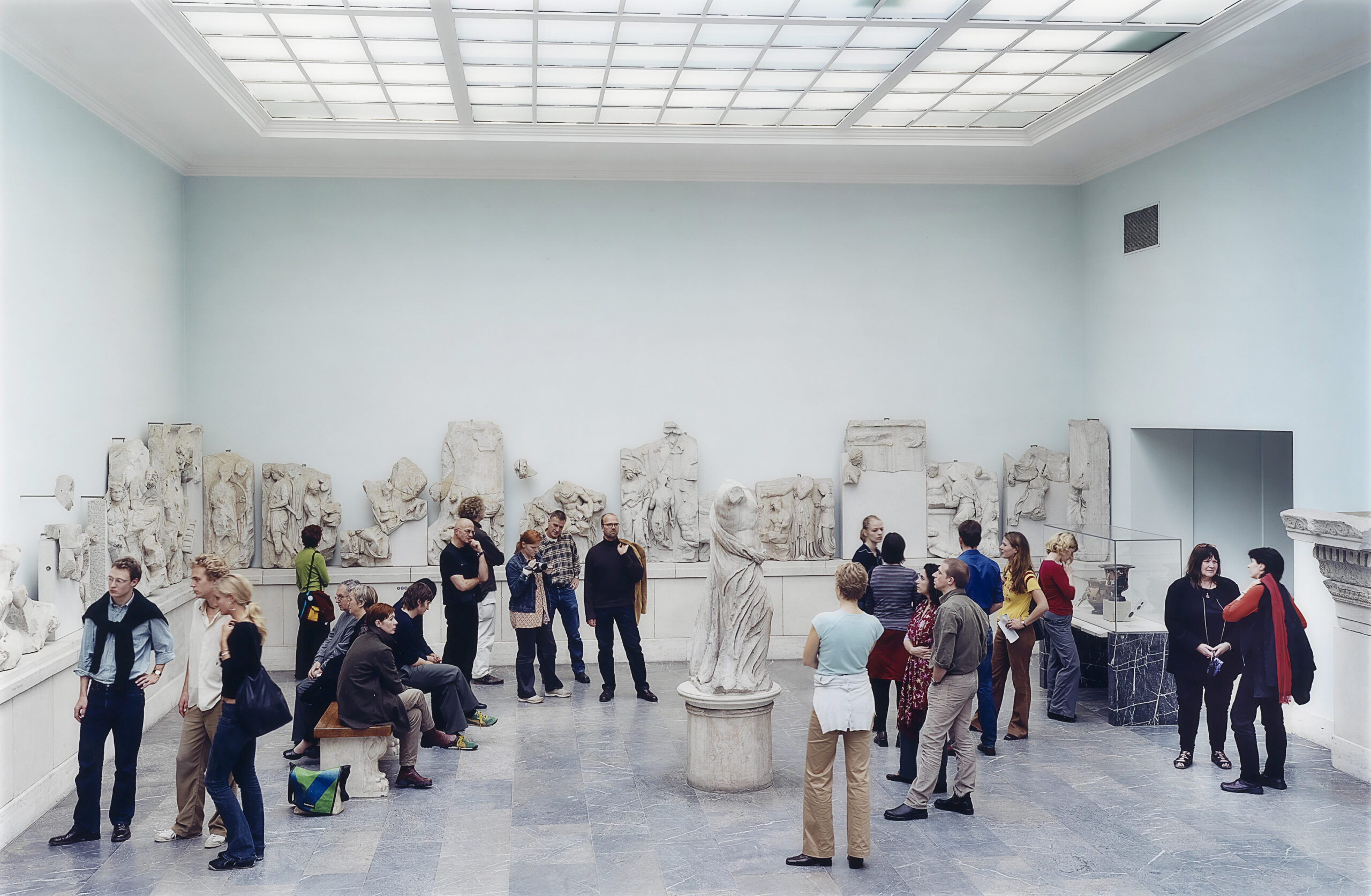
Thomas Struth’s Pergamon Museum IV, Berlin (2001). National Gallery of Victoria
We are hardly surprised by this — it is part of an exhibition, and it is in an art gallery. The past of 2001 — a group of people arranged around a room in a gallery — is shown in contemplation of the past of more than 2000 years before, suggesting how any photograph, whatever its primary intent, also acts as a record of the time it was made. That photographic record may be as open to interpretation as the surviving fragments of an ancient frieze, but both photo and frieze qualify as history as well as art.
In looking at photographs on display on the walls of a museum or a library, as opposed to a public or private art gallery, we are very much primed to read the images the other way, as history first and art, if at all, second. The exhibitions currently at the State Library of New South Wales and the National Archives of Australia take different approaches to the question of photography’s role in illuminating the past, and of how we should read photographs on display as history — but also, sometimes, as art, depending both on the innate qualities of the image and the institutional setting.
Shot: 400 Photographs, 200 Photographers, 3 Centuries inaugurates the State Library’s new photography gallery, a subterranean space created out of an old storage area once filled with “empty filing cabinets and the like.” It is difficult to think of a more striking metaphor of how photography has assumed a much more prominent role in our public collections, pushing its way forward by way of adaptive reuse.
The role of photography as historical record is emphasised by the organising principle of the exhibition — at least one photograph from nearly every year from 1845 to 2022. The library holds something in the order of two million photograph images; 400 are on display in Shot. This disparity in these numbers gives some idea of the curatorial task involved in choosing what to include.
The library’s inauguration of a dedicated space for displaying photographs is to be applauded, but it is hard not to notice, when descending into the former storage area, how limited that space is. The walls feel crowded, with some images mounted so high that details are almost out of visual reach. They can be examined more closely, however, on one of the wall-mounted monitors that have been distributed around the display area.
This combination of physical and electronic display seems deliberately to be raising the question of how we most effectively comprehend the vastness of Australia’s archive of photographic history. The viewer is being encouraged to see the images on the walls as a starting point, an encouragement to engage in further exploration online. “These 400 works,” we are advised in the useful if all too brief booklet that accompanies the exhibition, “convey some of the rich rewards to be gained by examining the archive as a whole,” suggesting how the role of curator is moving speedily through a process of democratisation — just as photography itself has undergone a similar process over many decades.
On the evidence of one moderately busy morning, that strategy is working: the monitors in the room were all taken up by people zooming in on details of the image — or seeking out further background information, or comparing one image with another — while others patiently waited their turn.
Shot explicitly challenges any distinction between “art” and “documentary” photography, consigning that distinction, not altogether convincingly, to history, to the twentieth century when “the ‘art-hang’ was a popular method for exhibiting the work of artist-photographers.” The library doesn’t abide by that distinction, instead choosing a middle way between a gallery-style “art-hang” and what might be called a documentary-hang. “If they’ve got visible sprocket holes, for example, that’s how we reproduce them.”
The many photographs in the library’s collection have been “sourced from official documents,” from shoeboxes and mantelpieces and from the archives of newspapers and portrait studios, but there are also images that we would conventionally think of as being more at home on the walls of art galleries. Max Dupain’s The Sunbather is there (in two versions) along, for example, with a beautiful autochrome Still Life (1912–20) by an unknown photographer, and Anne Zahalka’s 1988 Cibachrome print The Sisters, which also, as it happens, includes a still life, in the bottom right hand corner of the frame. Zahalka’s is a brilliant image, its forthright compositional techniques — its multiple references to framing, for example — and its combination of visual formality and domesticity inviting reflection on what a difference a frame makes.
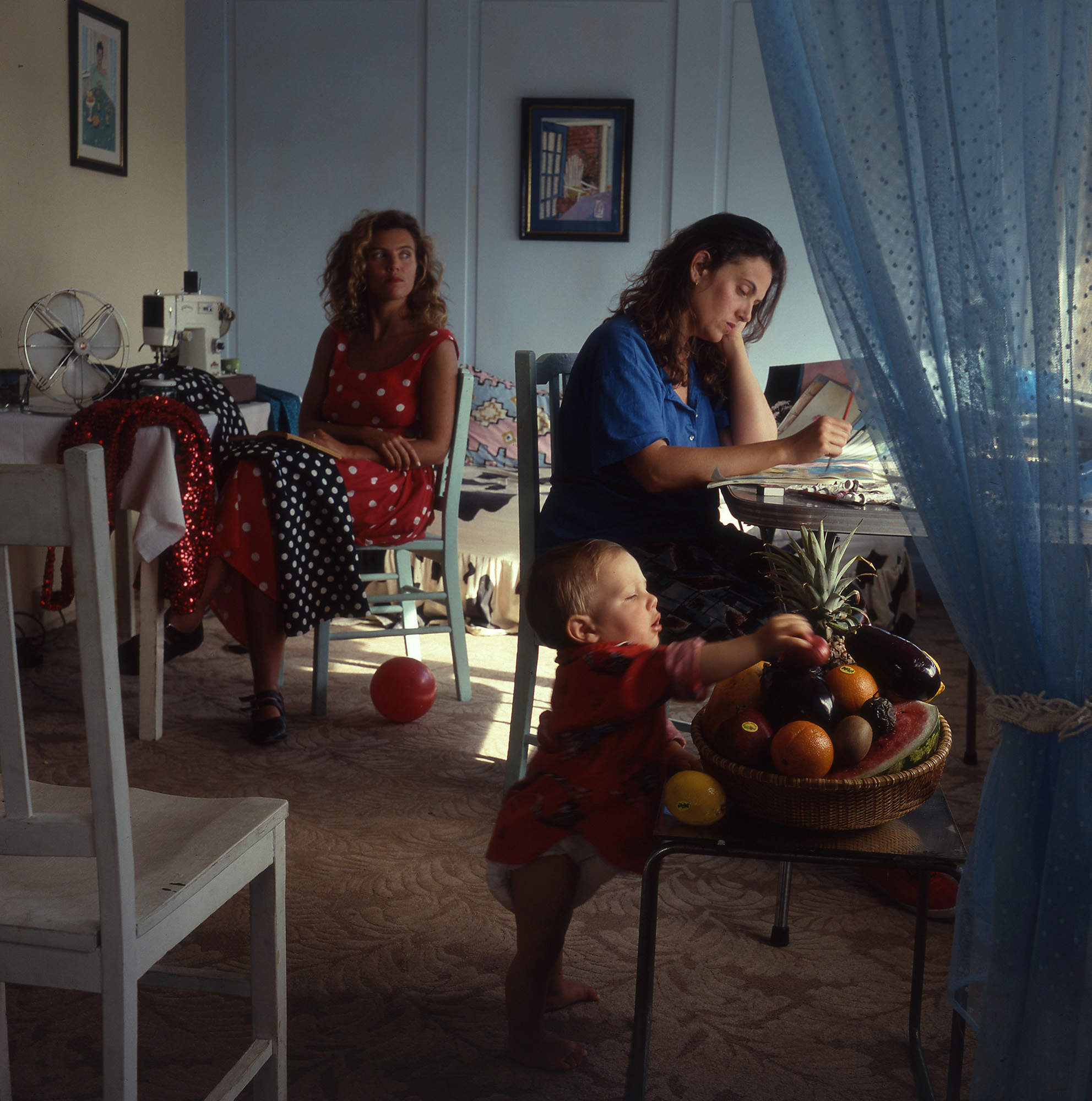
Anne Zahalka’s The Sisters (1988). State Library of New South Wales
The inclusion of works by Dupain and Zahalka emphasise the fact that, in addition to their status as photographic art, these images are also part of Australian history and of the time in which they were made. The exhibition makes the further point that all manner of photographic output — studio portraiture, holiday snaps, photojournalism, police mug shots, “art photography” — documents the past, and indeed that examples of all those genres have a place in the library’s collection.
“Most of the Library’s photographs,” remarks curator Geoffrey Barker in the exhibition booklet, “have been acquired for their documentary value rather than for their artistic or aesthetic value, but… when visitors look at these photographs they will realise that often there’s not much between them and art photography.”
Some images, rather more than others, bear out this contention. Photo Kiosk (1949), for example, by the little-known Brian Bird, captures a moment in history, but it would also look perfectly at home displayed among the work of the world’s great mid-century street photographers. As an indication of the richness and variety of the library’s holdings — and by extension of the country’s photographic heritage — the exhibition is best seen as it suggests we see it, as an incentive to look further, to explore and curate these collections for ourselves.
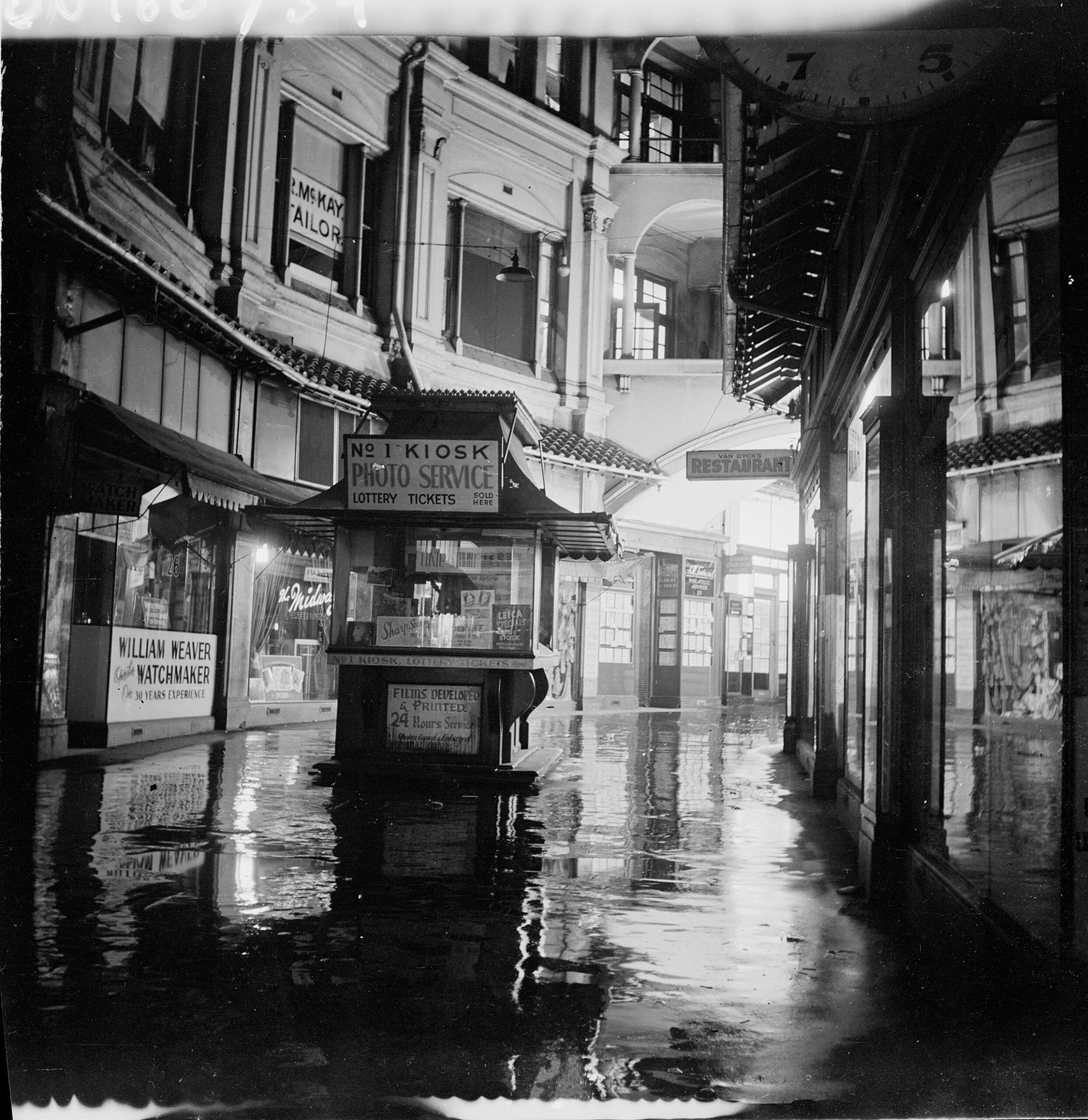
Brian Bird’s Photo Kiosk (1949). State Library of New South Wales
The selection criterion for Focus: Australian Government Photographers at the National Archives of Australia in Canberra, is quite different. This is a selection of the images produced by the professional photographers employed, in various capacities and under various departmental headings, by the federal government. This system of direct employment lasted from its inception in 1939 until 1996, when it gave way to outsourcing.
The job of these photographers was, as Martyn Jolly puts it in his introduction, to “show off” Australia, its landscape, its industry and way of life. The photographs were destined to be printed in brochures and departmental reports, often without attribution. “They weren’t,” says Jolly, “taken for the gallery wall.” And yet here they are, framed and attributed and looking very much like art.
Many photographers worked for the government in this way. Eighteen are represented in the exhibition, complete with names and brief biographical details, the recovery of which in many cases required diligent research. Only one, the pioneering Aboriginal photographer Mervyn Bishop, could be described as widely known outside professional circles.
The names of the other seventeen will almost certainly be less familiar, including that of the sole woman among them, Jocelyn Burt, for whom entry into the world of professional photographers was no easy task. “I ran headlong into male chauvinism before I even started to work professionally,” she says in her laconically knockabout memoir Shutterbug in the Bush (1981).
Seeing these works displayed alongside one another gives an idea of the tightly encompassing brief to which the photographers were working. The human subjects look happy or purposeful or occasionally pensive, with few images of suffering or deprivation and only occasional ones of delicately implied sadness. People are typically arranged in groups, working on some common task or engaging in sport or leisure activities in a spirit of cheerful competitiveness. (Buildings, meanwhile, are shown as modern and clean-lined, embodying Australia’s commitment to the future.)
We cannot help but be conscious of how people have been directed to stand here or there or hold their heads just so. In John Tanner’s Workers at the BHP Steelworks (1956), for instance, a trio of men in hard hats gazes towards the future. One of the men is shown with his arm draped over the shoulder of his colleague, looking very much as if this is the first time he has ever done such a thing. And yet the image works. It conveys both the social constraints and the essential optimism of the time, suggesting by the bright-eyed way in which the men look into the distance that, those social constraints notwithstanding, the future is open.
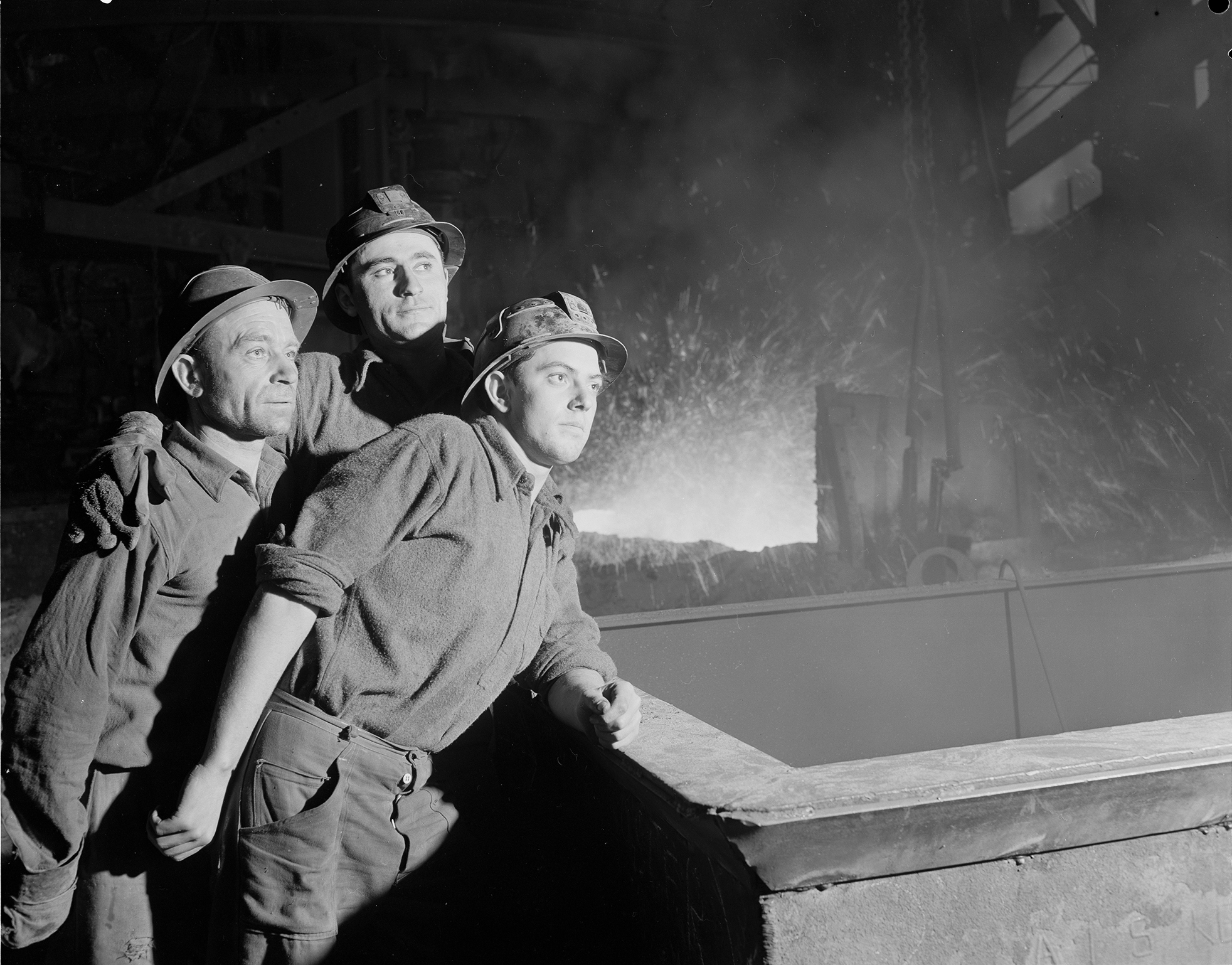
John Tanner’s Workers at the BHP Steelworks (1956). National Archives of Australia
While the emphasis is on the vitality of youth, the relatively fewer images of older people treat them with an amused affection. In Jim Fitzpatrick’s Fruit Connoisseurs Assess the Produce (1968) three elderly women in complementary hats look balefully at a display of apples, determined not to be fooled by anything less than the best, while in Keith Byron’s Veteran Punter Outsmarts the Flies (1969) the veteran of the title, with netting draped over his hat, conveys a similarly robust resourcefulness.
It is Byron’s work, along with Mervyn Bishop’s, that most stands out among these resonant images; Bishop’s for his ability to capture both social disadvantage and genuine spontaneity in his pioneering photographs of First Nations people, and Byron for his instinct for unshowily combining documentary and art. Byron’s Tensions Run High Among Brokers at the Melbourne Stock Exchange (1968), with its multiple visual cross-references, is one to keep coming back to.
Given that the national stock of photographs is almost unimaginably vast, it is not realistic to think that more than a very small proportion can ever be displayed on the walls of cultural institutions. Just as we are all photographers now, so we are being encouraged to become curators too, exploring and researching the national collections for ourselves.
We don’t yet know where artificial intelligence is taking the practice of photography itself but, as Martyn Jolly points out, AI can already assist immeasurably in productive searching, finding links and illuminating correspondences that might otherwise emerge only by chance. Whatever its implications for the future of photography, when it comes to getting the most out of the photographs we already have, AI could well be a good thing. •
Photography: Real and Imagined
The Ian Potter Centre, NGV Australia, until 4 February 2024
Shot: 400 Photographs, 200 Photographers, 3 Centuries
State Library of New South Wales until 3 November 2024
Focus: Australian Government Photographers
National Archives of Australia until 10 June 2024
